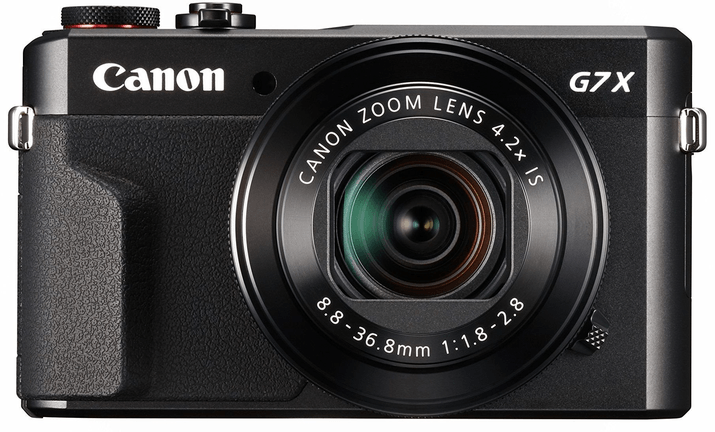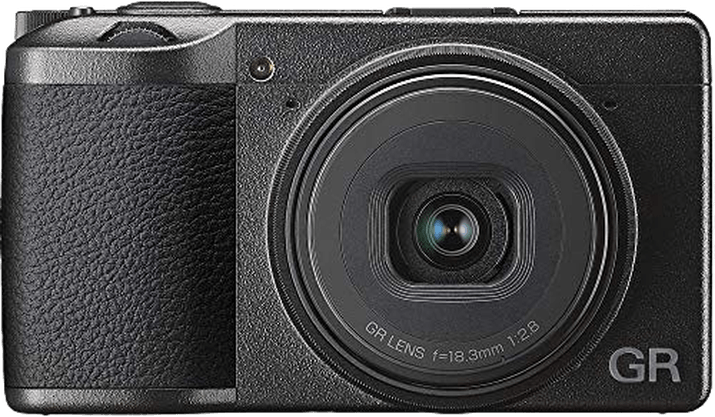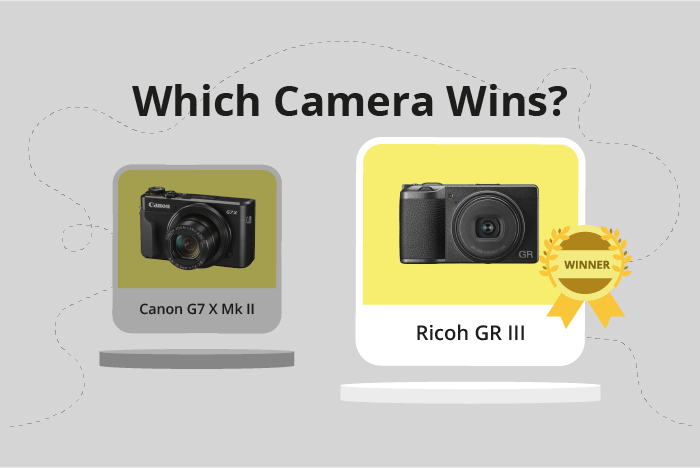Canon PowerShot G7 X Mark II vs Ricoh GR III Comparison
Canon PowerShot G7 X Mark II

Ricoh GR III

The Ricoh GR III comes out ahead with a score of 66/100, while the Canon PowerShot G7 X Mark II trails at 59/100. Both cameras are compact, released in 2016 and 2018, respectively. They share similarities in their size: Canon (106 x 61 x 42mm) and Ricoh (109 x 62 x 33mm).
The Ricoh GR III has advantages such as its lighter weight (257g) and higher overall score. On the other hand, the Canon PowerShot G7 X Mark II has a lower launch price ($699) compared to the Ricoh GR III ($899), making it a more affordable option.
Taking into account the specifications and differences, the Ricoh GR III emerges as the better camera with its higher score and lighter weight. However, the Canon PowerShot G7 X Mark II could be a more budget-friendly choice for those prioritizing price.
Canon PowerShot G7 X Mark II vs Ricoh GR III Overview and Optics
The Ricoh GR III is the winner in our optics comparison, scoring 68/100, while the Canon PowerShot G7 X Mark II lags behind with a score of 58/100. Both cameras have 20 and 24 megapixels respectively, use CMOS sensors, and have fixed lens mounts, meaning the lenses cannot be changed.
The Ricoh GR III surpasses the Canon PowerShot G7 X Mark II in several aspects. First, it has a higher megapixel count at 24, compared to Canon’s 20 megapixels. This allows for more detailed and higher resolution images. Second, the Ricoh GR III has a larger APS-C sensor size, which contributes to better image quality, especially in low light conditions. Lastly, the Ricoh GR III features image stabilization, making it easier to capture sharp images in various shooting conditions.
On the other hand, the Canon PowerShot G7 X Mark II has some advantages as well. It has a faster shooting speed of 8 frames per second, compared to the Ricoh GR III’s 4 frames per second. This makes it more suitable for capturing fast-moving subjects. Additionally, its Digic 7 processor has a higher DXOMARK score of 79, compared to the Ricoh GR III’s GR Engine 6 processor with a score of 76. This indicates that the Canon PowerShot G7 X Mark II has better sensor performance.
To conclude, the Ricoh GR III is superior in terms of optics, with its higher megapixel count, larger sensor size, and image stabilization. However, the Canon PowerShot G7 X Mark II holds its ground with a faster shooting speed and better sensor performance. Ultimately, the choice between these two cameras depends on the user’s priorities and preferences.
Canon PowerShot G7 X Mark II vs Ricoh GR III Video Performance
The Canon PowerShot G7 X Mark II and the Ricoh GR III have an equal video score of 70/100. Both cameras share identical video specifications, with a maximum video resolution of Full HD (1920 x 1080) and a maximum video frame rate of 60fps. Additionally, both cameras have built-in time-lapse functionality.
Comparing the video capabilities of the two cameras, it is clear that neither has a significant advantage over the other. Both cameras provide users with the ability to capture high-quality video footage at Full HD resolution and a smooth 60fps frame rate. The inclusion of time-lapse functionality in both cameras also allows for creative video capture.
While the Canon PowerShot G7 X Mark II and the Ricoh GR III have the same video score, it does not mean that one camera is better than the other in terms of video capabilities. Instead, it indicates that both cameras offer similar video performance, catering to the needs of users who prioritize video capture in their photography.
Considering the equal video score and the shared specifications between the Canon PowerShot G7 X Mark II and the Ricoh GR III, it is evident that both cameras are strong contenders in the video department. Users can confidently choose either camera for their video needs, as both provide high-quality video capture with time-lapse functionality.
Canon PowerShot G7 X Mark II vs Ricoh GR III Features and Benefits
The Canon PowerShot G7 X Mark II and the Ricoh GR III both have a feature score of 70/100, making them equal in this aspect. Both cameras have several features in common: 3-inch screens, touchscreen capabilities, no GPS, Wi-Fi, and Bluetooth connectivity.
The Canon PowerShot G7 X Mark II is superior in terms of screen resolution with 1,040,000 dots compared to the Ricoh GR III’s 1,037,000 dots. Additionally, the G7 X Mark II has a flip screen, which the GR III lacks. This feature makes the G7 X Mark II more versatile for different shooting angles and situations, such as vlogging or taking selfies.
On the other hand, the Ricoh GR III does not have any noticeable advantages over the Canon PowerShot G7 X Mark II in terms of features. Both cameras share similar specifications, making it hard to declare a clear winner in this aspect.
Ultimately, the Canon PowerShot G7 X Mark II edges out the Ricoh GR III in terms of features due to its slightly higher screen resolution and the presence of a flip screen. This makes the G7 X Mark II more suitable for users who require the flexibility of a flip screen for various shooting scenarios. However, the Ricoh GR III remains a solid option for those who prioritize other aspects of a camera, such as optics or video capabilities, and do not require a flip screen.
Canon PowerShot G7 X Mark II vs Ricoh GR III Storage and Battery
The Canon PowerShot G7 X Mark II wins the storage and battery comparison with a score of 29/100, while the Ricoh GR III scores 27/100. Both cameras have one memory card slot and accept SD, SDHC, and SDXC (UHS-I compatible) cards. They also both offer USB charging.
The G7 X Mark II outperforms the GR III in battery life, providing 265 shots per charge compared to the GR III’s 200 shots. This longer battery life is due to the Canon’s NB-13L battery type.
The Ricoh GR III, however, has an advantage in storage options, as it includes internal storage in addition to the memory card slot. This feature allows for more storage flexibility.
Considering these factors, the Canon PowerShot G7 X Mark II is the better choice for longer shooting sessions, while the Ricoh GR III offers additional storage options.
Canon PowerShot G7 X Mark II vs Ricoh GR III – Our Verdict
Are you still undecided about which camera is right for you? Have a look at these popular comparisons that feature the Canon PowerShot G7 X Mark II or the Ricoh GR III:

